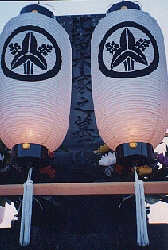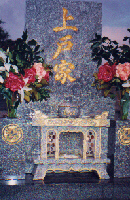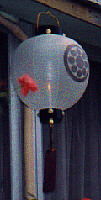1999 Festival of the Dead
Obon Rained Out
Fukue City, Nagasaki Prefecture, Japan
 IT RAINED this year during
Obon, the Japanese Buddhist Festival of the Dead,
for the first time in my experience.
IT RAINED this year during
Obon, the Japanese Buddhist Festival of the Dead,
for the first time in my experience.
The precipitation was not heavy or constant, but enough to make people think twice about risking their chouchin (lanterns). Though they are only made of paper and wood, the kamon (family crest) design is custom painted, and they can be expensive to repair or replace!
My paternal grandfather's house is close to the temple, so we could wait for a break in the rain to go to the cemetery where my father's family's ohaka (grave or tomb) is. We hung just one row of lanterns (instead of our usual three) and sat nearby, ready to take them down quickly if the rain started again. We were almost the only (living) people there! There were other ways of showing respect:
Other families didn't even go to the cemetery, but instead stayed home
and hung a lantern outside their door or window
(RIGHT).
Only three of my relatives came to Fukue (almost none of them live there), and it seemed there were less people around the cemetery than in previous years. With the 20th century trend towards urbanization, most Japanese live nowhere near their family ohaka, which are often in little rural villages. Maybe fewer could afford to travel as a result of the fukeiki (economic depression) in which Japan has been mired for the past few years. Also, the attitude of Japanese people toward traditions is changing.
So, it was a different Obon this year: quiet, solitary, and actually cool. No hanabi (fireworks) during the two rainy days. It might have even seemed not worth the effort if not for the words of my Great-Aunt Yuki. The last (coherent) representative of her generation on my father's side, she perhaps spoke for all my ancestors:
Thank you for coming back and remembering us." |
Images of Obon 1993: 1 | 2 | 3 | 4 | 5 | Q & A | Links
About Hatsubon - Honouring those who died in the past year
Visit the Virtual Tomb if you dare ...
Obon-fest '99 - Portland, Oregon, USA

 Some families had an ohaka with a built-in alcove
(LEFT),
where they could place a lit candle and let it burn,
sheltered from the elements, while they scurried home to stay dry.
Some families had an ohaka with a built-in alcove
(LEFT),
where they could place a lit candle and let it burn,
sheltered from the elements, while they scurried home to stay dry.